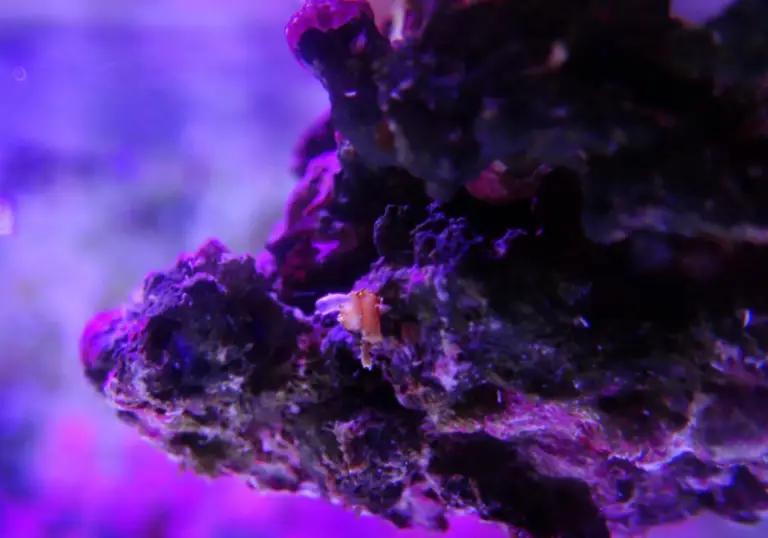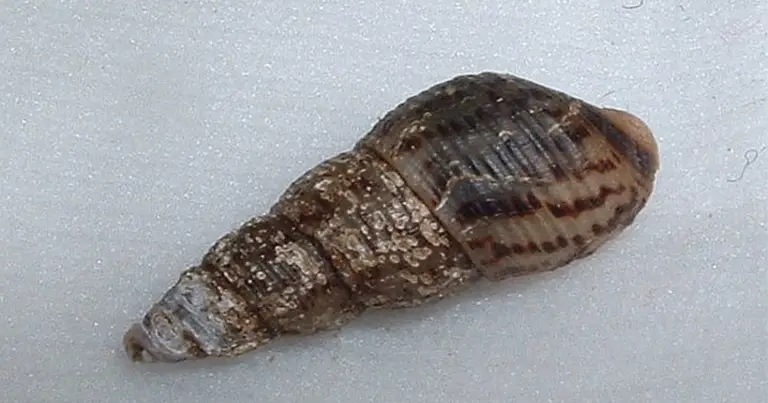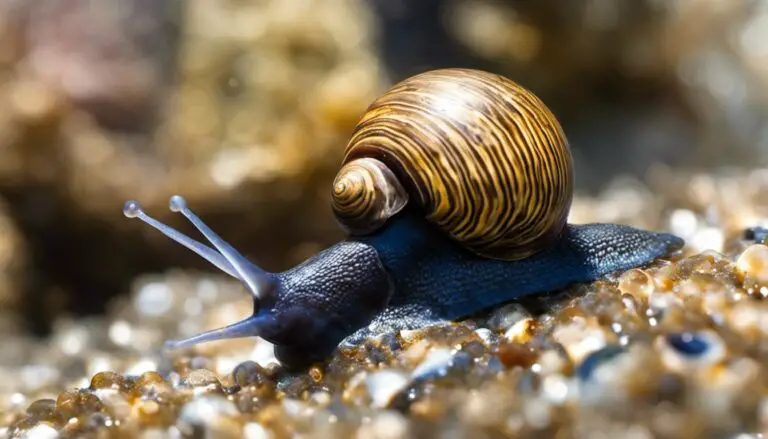Do Mystery Snails Get Lonely? Debunking the Myths
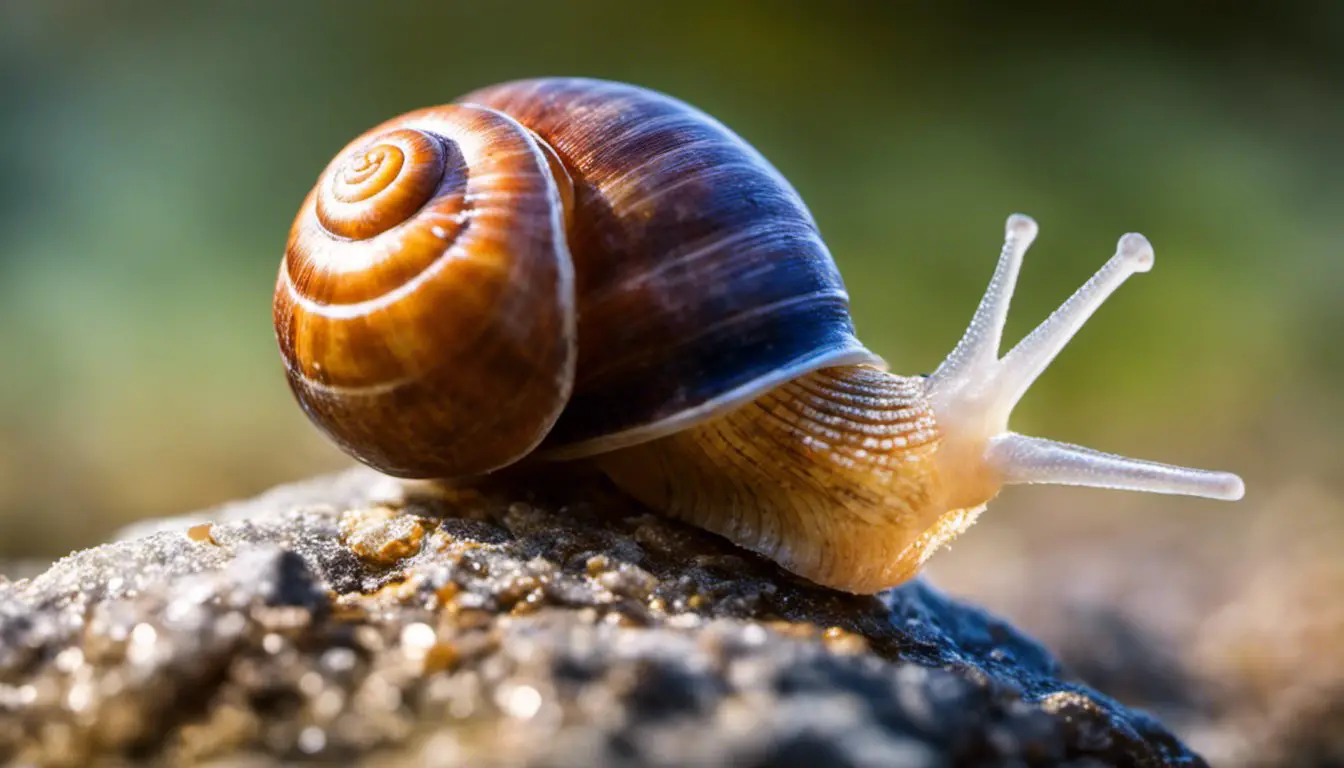
Mystery snails are fascinating creatures, often found in home aquariums. They are known for their easy care, ability to clean algae, and their unique appearance. A common question among hobbyists is, Do Mystery Snails Get Lonely, and is having tank mates necessary for the well-being of our shelled friends?
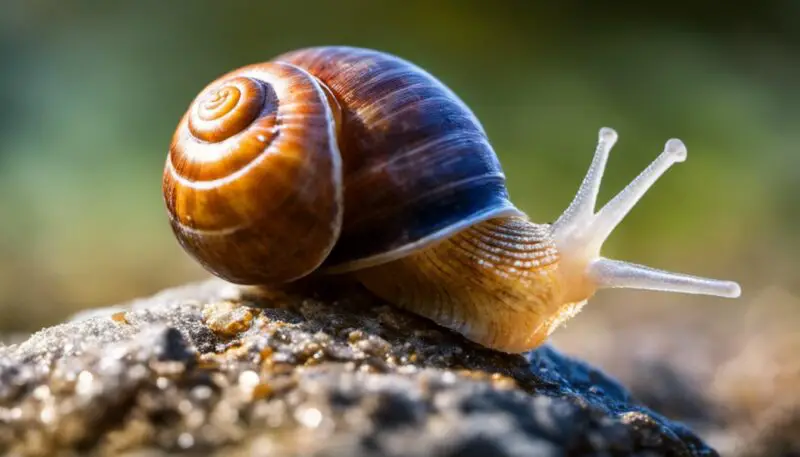
The truth is that mystery snails are generally solitary creatures. They can thrive in your aquarium without the need for companionship. However, that doesn’t mean they can’t coexist with other tank inhabitants. Introducing certain species, such as nerite snails, can add diversity to your aquarium without the risk of overpopulation through breeding.
In summary, while your mystery snail may not necessarily crave company, it’s still perfectly fine for them to share their aquatic environment with other compatible creatures. As an owner, monitoring your tank’s conditions and occupants is essential to ensure a healthy and stable environment for all inhabitants.
Contents
Table of Contents
The Nature Of Mystery Snails
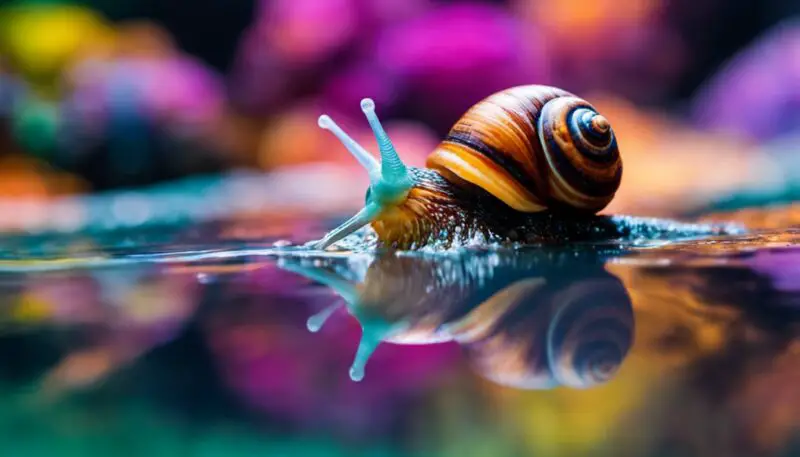
Mystery snails, also known as Pomacea Bridgesii, are a popular freshwater snail species native to South America. They can be found in countries like Brazil, Bolivia, Paraguay, and Peru. With a typically easy-going nature, these snails are excellent additions to your aquarium.
Adding mystery snails to your home aquarium might make you wonder if they get lonely and require companionship. Mystical snails do not have a social nature like many other aquatic creatures. They are generally content with living in solitude or with other mystery snails. Most importantly, it is essential to maintain the water quality and diet for them to thrive, regardless of the company they have.
Mystery snails are versatile and can also coexist with other snail species, like nerite snails, without any issues. However, be aware that different snail species may not breed with each other, so you don’t have to worry about population control when housing them together.
In terms of their habitat, mystery snails require clean and stable environments to live a long and healthy life. While they are known to consume algae, making them excellent natural cleaners, providing them with a balanced diet can work wonders in maintaining their overall health. In typical conditions, mystery snails have a lifespan of 1 to 2 years, but with optimal care, they can live up to 3 years.
By understanding the nature of mystery snails, you’ll be more confident in providing the right environment for them to thrive. Remember to focus on their habitat, diet, and compatibility with other aquatic creatures when adding them to your aquarium.
Different Varieties And Appearance
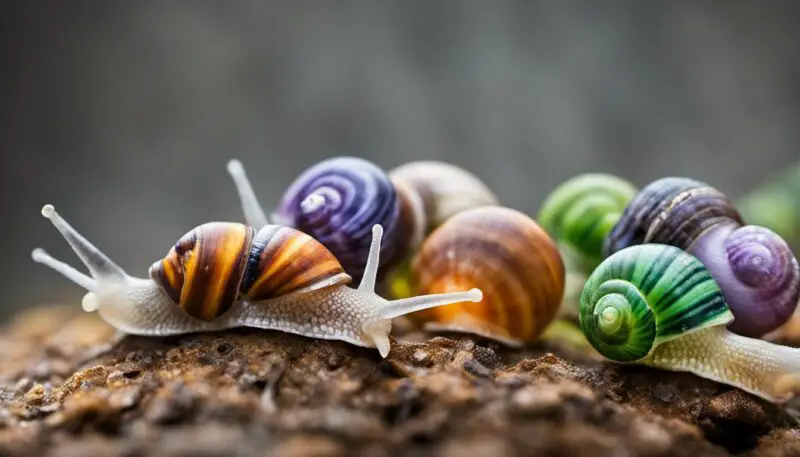
Mystery snails come in various colors and patterns, making them a visually appealing addition to your aquarium. The shell colors can range from yellow, green, purple, or white (ivory). Their shells also display diverse patterns, allowing for unique combinations that create a visually pleasing environment for you and your aquatic friends.
The foot of the snail, the part responsible for movement, is usually black or tan, depending on the color of the shell. Some mystery snails also showcase more vibrant colors, such as blue and magenta, contributing to their popularity among hobbyists.
Their shells’ size and diameter can vary, but their general appearance remains consistent across different color morphs. Mystery snails have an operculum, which is a plate-like structure that serves as a door to seal the snail inside its shell. This unique feature not only adds intrigue to their appearance but also provides them with a level of protection against potential predators.
When observing your mystery snails, you can feel confident knowing that your aquarium is home to an aesthetically fascinating creature. Their various colors, unique shell patterns, and distinctive appearance make them a valuable addition to any aquatic habitat.
Mystery Snail Anatomy
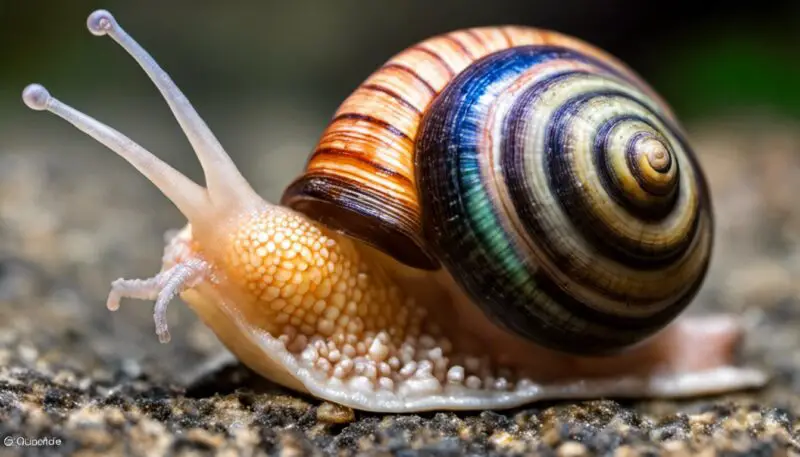
When observing your mystery snail, you will notice several distinct features that make up its unique anatomy. Understanding these features can help you better care for these fascinating creatures.
The first feature to note is the siphon. The snail uses this long, tube-like structure to breathe air from the water’s surface. The siphon is connected to the mystery snail’s gills which are responsible for extracting oxygen from the water.
Another important aspect of their anatomy is their eyes. Mystery snails have a pair of small, round eyes at the base of their tentacles. These eyes and tentacles help the snail navigate their environment and search for food.
The foot of a mystery snail is a wide, muscular structure used to move around. The foot is relatively strong, allowing them to move easily across various surfaces in the aquarium. When you see your mystery snail gliding along the walls or bottom of the tank, it uses its foot to do so.
The operculum is another essential part of the mystery snail’s anatomy. This thin, hard plate functions as a door when the snail withdraws into its shell, protecting it from potential predators and helping it maintain moisture in its body.
In summary, understanding the anatomy of your mystery snail, including the siphon, gills, eyes, tentacles, foot, and operculum, is crucial for providing the proper care they need. By being confident and knowledgeable about their anatomy, you can better appreciate these charming aquarium inhabitants and ensure their health and well-being.
The Habitat of Mystery Snails
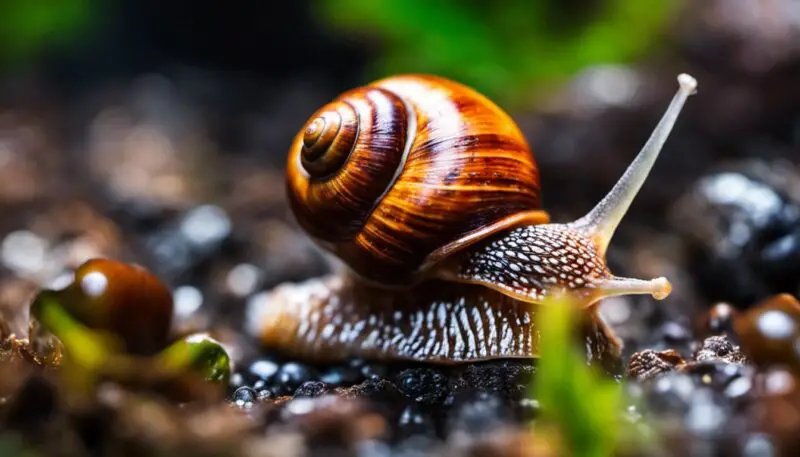
When setting up a suitable environment for your mystery snails, it’s crucial to consider key factors such as appropriate habitat, substrate, tank setup, size, and overall tank conditions. In doing so, you can ensure that your snails live a healthy, happy life.
Mystery snails come from South America, predominantly found in regions like Peru, Paraguay, Brazil, and Bolivia. They usually inhabit rivers, swamps, and ponds, where they scavenge for plant matter. Replicating their natural habitat as closely as possible in setting up your freshwater tank is vital.
You should begin with a clean, spacious tank (minimum tank size of 5 gallons per snail), as this gives your snails ample room to move around and helps maintain better water quality. Your substrate choice plays a significant role, as mystery snails prefer a soft, sandy substrate that allows them to dig and bury themselves easily. Moreover, adding smooth rocks, driftwood, and other hiding places can mimic their natural environment and provide a more enriching experience.
Proper tank setup and water conditions are essential for your snails. Ensure that the freshwater tank has a stable pH level between 7.0 and 7.5. It is also crucial to maintain a consistent temperature range of 68°F to 82°F. Keep up with regular maintenance, such as water changes and monitoring water quality, to provide an optimal environment for your snails.
Investing in a secure and tight-fitting lid can prevent snails from escaping, as they can sometimes crawl up the glass walls of the tank and end up out of the water. Additionally, the lid will help maintain a consistent temperature and water quality.
Adhering to these guidelines for creating the ideal habitat for your mystery snails will provide them with a comfortable and thriving environment. Remember to keep the tank clean, be mindful of the water conditions, and replicate their natural habitat to ensure their well-being and happiness.
The Diet Of Mystery Snails

Mystery snails are fascinating little creatures, and one of the key aspects to keeping them healthy in your aquarium is understanding their diet. Being omnivorous, they tend to consume various food sources. Let’s dive into the details of their diet.
Firstly, algae is one of the primary sources of nourishment for mystery snails. They often graze on the algae growing on your aquarium’s glass, decor, and plants. By doing so, they help keep the tank clean and maintain a balanced environment.
However, even though algae are essential to the mystery snails’ diet, they must supplement their meals with other nutrient-rich foods. For example, your snails may enjoy leafy vegetables, like spinach, which is an excellent source of vitamins and minerals. You can simply blanch and sink the spinach in the tank for the snails to enjoy.
You can incorporate some store-bought food items like algae wafers and sinking pellets to ensure they get enough nutrition. These specifically designed, nutrient-dense foods support the snails’ growth and provide them with a well-rounded diet. In addition, sinking pellets are vital since mystery snails prefer consuming food at the bottom of the tank.
Another aspect to consider is that mystery snails frequently consume detritus in their natural habitat. While they help manage this waste in your tank, it’s essential to maintain the overall cleanliness by regularly removing any excess detritus yourself.
Finally, although your snails might nibble on fish food leftovers, it’s not their primary food source. Make sure to feed them specifically formulated snail food to meet their nutritional needs and keep them healthy and active in your tank.
By understanding and catering to the diet of your mystery snails, you’ll ensure their well-being and contribute to a thriving aquarium ecosystem.
Do Mystery Snails Get Lonely? The Truth about Mystery Snails
Understanding Mystery Snail Behavior
Mystery snails are fascinating creatures with intriguing behavior that can keep you engaged for hours. They are known for their peaceful temperament and can make an excellent addition to your tank.
Firstly, it is essential to note that mystery snails are not social animals, which means they do not necessarily get lonely or need companionship. However, they can coexist with other aquarium species, such as nerite snails and some fish, provided the tank conditions are compatible.
Mystery snails spend most of their time scavenging for food and cleaning your tank. They can keep your tank clean by eating algae, uneaten fish food, and decaying plant material. You will often see them moving around the tank, using their eyestalks to locate food and navigate their environment.
As nocturnal creatures, mystery snails tend to be more active at night, while you may find them motionless for extended periods during daylight hours. This behavior is entirely normal and should not be a cause for concern.
As a mystery snail owner, you may witness them occasionally trying to escape their tank. This behavior is due to their instinct to search for food or a different environment. To prevent such escape attempts, maintain water quality, and provide a secure tank lid. Keeping the water level slightly lower than the tank edge will discourage them from climbing out.
Tank Mates Compatibility And Environment

When considering tank mates for your mystery snails, providing a suitable environment compatible with various species is essential. Creating a harmonious community tank can ensure your mystery snails do not get lonely and thrive in their surroundings.
Mystery snails prefer a tank size of at least 10 gallons to move around comfortably. The tank environment should have a temperature ranging from 68 to 84°F, with a pH between 7.0 and 8.5. Also, water hardness should be maintained between 12 to 18 dGH to ensure your mystery snail’s shell remains healthy.
Regarding plant life, live plants such as Anubias, Java Fern, Hornwort, and Java Moss are excellent additions to a mystery snail’s environment. These plants provide natural hiding spots and a stable ecosystem for the snails and their tank mates.
When it comes to tank mates, mystery snails are generally compatible with many fish and invertebrates. For instance, Nerite snails are a great match as they share similar water parameter requirements, making them perfect additions to the tank. However, be cautious with aggressive fish like Betta fish, as they may harass or attack your snails.
Mystery snails can coexist with various fish, such as dwarf gouramis, platies, mollies, and tetras. Maintaining a peaceful community tank is crucial, ensuring all species can thrive without predation risk. Conversely, avoid placing crayfish in the same tank as your mystery snails, as they are known for their predatory behavior and may harm them.
By carefully selecting compatible tank mates, providing the right environment with suitable hiding spots, and maintaining proper water parameters, you’ll create a thriving community tank. In this way, you can alleviate the loneliness of your mystery snails and watch them flourish in a stimulating and secure environment.
Water Conditions And Requirements
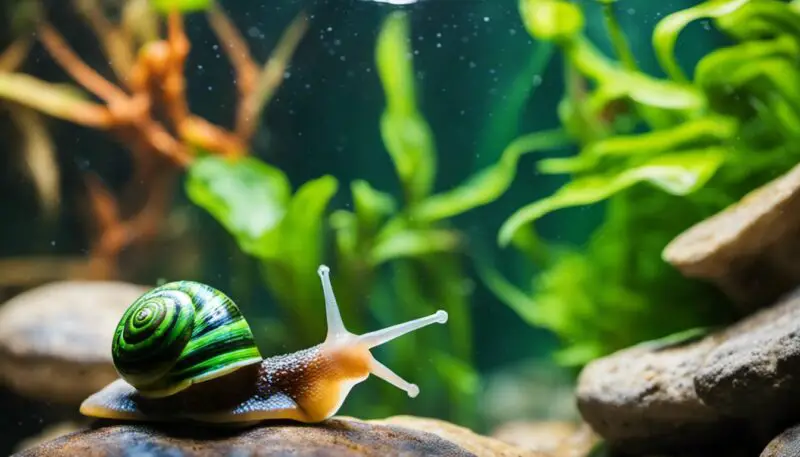
Managing the water conditions in your aquarium is crucial to ensure the well-being of your mystery snails. They thrive in stable environments with proper water parameters, which play a significant role in their health, growth, and breeding.
To maintain optimal water quality, monitor your tank’s temperature, pH levels, and ammonia. Your mystery snails prefer water temperatures between 68-84°F. Installing a reliable heater will help you sustain this range. Simultaneously, monitoring and maintaining your tank’s pH levels is vital, which should be kept between 7.6 and 8.4.
Potential hardness (dGH) should be between 12-18, as proper water hardness is important, ensuring your mystery snails have strong shells. You can achieve this balance by using commercial additives or adding crushed coral to your aquarium.
Regularly testing the water for ammonia, nitrite, and nitrate levels is vital for the health of your mystery snails. Both ammonia and nitrite should be kept at 0 ppm, while nitrate levels should be under 20 ppm. Conducting partial water changes and using a suitable filtering system will help maintain water quality.
Remember that mystery snails are sensitive to sudden fluctuations in water conditions. Adjusting by gradually acclimating your snails and monitoring the water parameters using an appropriate test kit is essential.
By providing the right water conditions and requirements for your mystery snails, you’ll support their growth, longevity, and overall well-being in your aquarium.
Health And Lifespan Of Mystery Snails

Mystery snails are fascinating creatures that can be a great addition to your aquarium. They have a lifespan of 1 to 2 years, but with optimal care, they can live up to 3 years. In this section, we’ll discuss some health issues that might affect your mystery snails and ways to ensure they live long and healthy lives.
One essential aspect of maintaining your mystery snails’ health is providing them with the right environment. The water temperature should be between 68 and 84 degrees Fahrenheit, and the pH should be maintained at 7.6 to 8.4. The water hardness should range from 12 to 18 KH. Additionally, it’s important to ensure the water is well-oxygenated and has a moderate flow, as mystery snails are sensitive to the presence of copper in the water.
Their diet plays a significant role in their health too. Mystery snails are not picky eaters and will consume various foods, including dead fish, dead shrimp, dead or rotting plant matter, and algae. Feeding them algae on aquarium glass and stones provides them with the best food additions.
Mystical snails help keep your tank clean by eating algae and serve as an early warning system for possible issues in your aquarium. If you notice your snails becoming sluggish or inactive, it might indicate a water quality problem or harmful substances.
Regularly monitoring the water conditions, maintaining a clean and stable environment, and providing a balanced diet for your mystery snails will ensure their overall health and longevity. These charming little creatures can be an excellent addition to your underwater world with proper care.
Breeding Of Mystery Snails
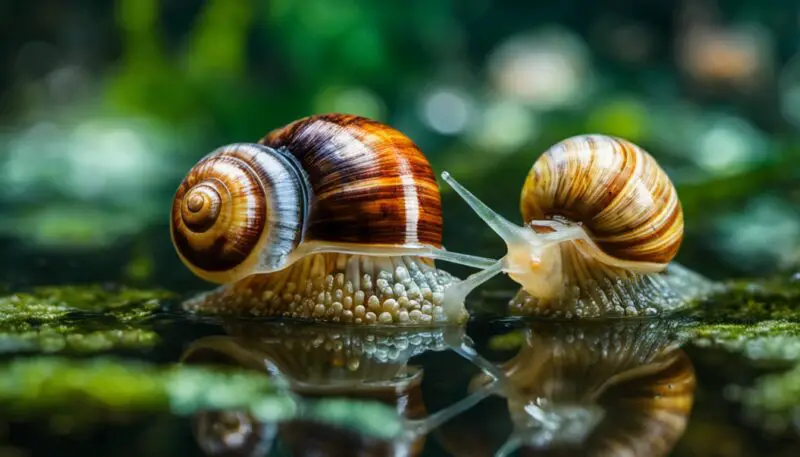
When you want to breed mystery snails, it’s essential to understand their reproductive habits and needs. These creatures are not hermaphrodites but rather gonochoristic, which means they require a male and female to reproduce successfully. To begin breeding, you must identify and separate sexually mature male and female snails.
One key aspect to note is the importance of maintaining a clean and stable environment for your snails. Their lifespan ranges from 1 to 3 years, depending on factors like water quality, diet, and overall tank conditions. Offering a balanced diet of plant-based foods and algae will help ensure their health throughout the breeding process.
When breeding mystery snails, providing them with a suitable environment within your tank is crucial. Ensure the water temperature is stable and falls within the optimal range for this species. The water should have a pH level between 7 and 7.5, and the tank should have a lid to ensure adequate humidity levels for egg-laying. Some snail enthusiasts include live plants in their aquariums to further cater to these creatures’ needs.
Mystery snails lay their eggs above the waterline, and it’s vital to accommodate this when setting up your aquarium. Provide a secure surface near the water’s edge where the female snail can deposit her eggs. Once mating occurs, you’ll notice small clusters of pinkish-brown eggs laid several inches above the waterline.
It’s important to monitor the humidity in this area, as it needs to remain adequately moist for the eggs to hatch successfully.
It takes around two to four weeks for the eggs to hatch, releasing tiny mystery snails into the tank. You’ll want to offer a nutrient-rich diet as they develop and grow stronger during this period. Larval snails might require a different food type than adult snails, so pay close attention to their specific needs.
By following these guidelines, you can successfully breed mystery snails in your aquarium while ensuring their health and happiness. Remember to maintain optimal water conditions, provide a balanced diet, and create a suitable environment for egg-laying and hatching. Soon enough, you’ll enjoy watching the tiny snails grow and thrive in your tank.
Caring For Mystery Snails

Caring for mystery snails is relatively simple, even for beginner aquarists. These snails prefer a calm environment, so choose an overcrowded tank and ensure the water temperature, pH, and hardness are in the appropriate range for their species.
Mystery snails are quite low-maintenance when it comes to feeding. Their natural diet consists of algae and other organic debris. However, you may supplement their diet with algae wafers or blanched vegetables to ensure they get enough nutrients. A balanced diet rich in calcium is vital for their shell health. Care guides are available to help you better understand their specific dietary needs.
When setting up your tank, ensure you have a tight-fitting lid, as mystery snails are known to escape. Additionally, this will help create a warm and humid environment for their eggs, preventing them from drying out.
One important aspect of caring for mystery snails is ensuring they have sufficient calcium in their environment. Calcium supplements can be added to the water, or you can provide cuttlebones to help maintain their shell health. You should also keep an eye on the pH level in the tank, as a low pH can impact their shells.
Maintaining a clean and stable environment is crucial for your mystery snails’ overall health. Regular water changes, testing for ammonia and nitrite levels, and maintaining proper filtration will help keep your snails healthy. Additionally, monitor the tank’s temperature, as they prefer temperatures ranging from 68 to 82 degrees Fahrenheit.
While mystery snails are known for their solitary nature, you may wonder if they get lonely. Generally, these snails are happy to be alone and don’t require tank mates for their well-being. However, adding more mystery snails or compatible fish can create a more interesting and dynamic environment that will be enjoyable for both you and your snails.
Following these recommendations ensures that your mystery snails are well cared for and live a healthy, happy life in your aquarium.
Frequently Asked Questions: Do Mystery Snails Get Lonely

Do aquarium snails require companions?
While aquarium snails can live peacefully with other tank mates, they do not require companions. Mystery snails are generally self-sufficient and can thrive in a tank even if they are the only snails present.
What are the signs of a happy mystery snail?
A happy mystery snail will be active, moving around the tank regularly and searching for food. Additionally, they should have a healthy shell without any cracks or damage, and their antennae should be extended and vibrant. If your snail is hiding frequently or not moving much, it might be a sign of stress or illness.
Is it okay to keep just one mystery snail?
It is perfectly fine to keep just one mystery snail in your aquarium. Mystery snails are not social animals, and they don’t require companionship. A mystery snail can thrive if you provide a suitable environment, proper diet, and clean water.
Do snails display signs of loneliness?
Snails, including mystery snails, do not display signs of loneliness as they are not social creatures. They primarily focus on finding food and maintaining their shells. You don’t need to worry about your snail feeling lonely, even if they are the only one in the tank.
How do mystery snails interact with other snails?
Mystery snails can coexist peacefully with others and generally do not engage in aggressive behavior. They may occasionally crawl over each other, but that’s just a part of their normal movement. However, it is essential to monitor the compatibility of mystery snails with other snail species, as some snails might eat each other’s shells or eggs.
What are important factors in mystery snail care?
Proper care of a mystery snail includes providing a suitable environment, stable water parameters, and a balanced diet. Ensure the tank has enough hiding spots, a clean and stable environment free of toxic substances, and a temperature between 68-82°F (20-28°C) with a pH ranging from 7.0-7.5 for optimal health.
Mystery snails mainly feed on plant matter, so provide them with various vegetables, algae wafers, and high-quality sinking pellets to ensure proper nutrition. Regularly clean your tank and change the water to maintain good water quality and avoid the growth of harmful bacteria.

